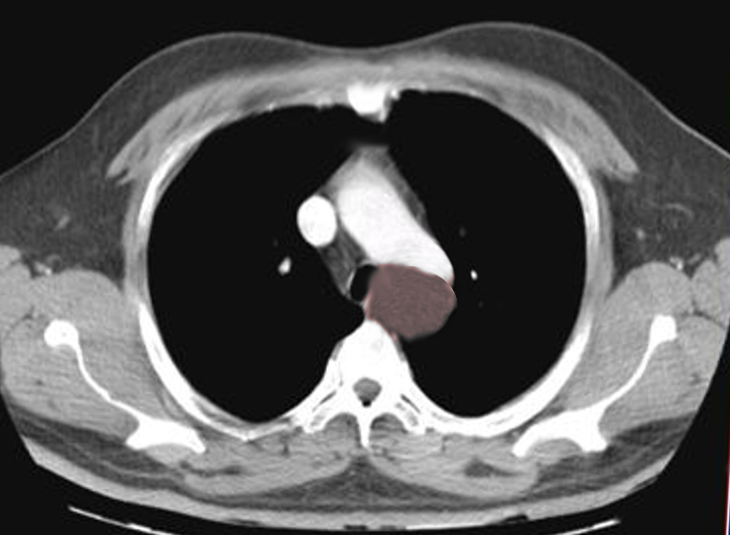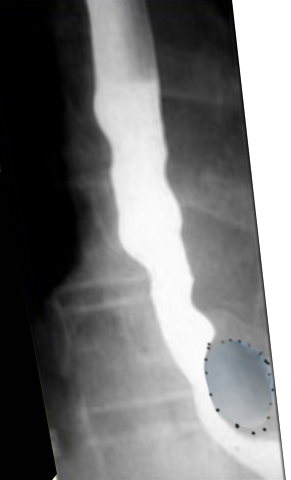[1]
Singhal V, Shenoy RD, Kamath N, Rao S. Mediastinal enteric cyst in a neonate. Journal of clinical neonatology. 2012 Jul:1(3):149-51. doi: 10.4103/2249-4847.101701. Epub
[PubMed PMID: 24027713]
[2]
Whitaker JA, Deffenbaugh LD, Cooke AR. Esophageal duplication cyst. Case report. The American journal of gastroenterology. 1980 Apr:73(4):329-32
[PubMed PMID: 7416128]
Level 3 (low-level) evidence
[3]
Wang B, Hunter WJ, Bin-Sagheer S, Bewtra C. Rare potential pitfall in endoscopic ultrasound-guided fine needle aspiration biopsy in gastric duplication cyst: a case report. Acta cytologica. 2009 Mar-Apr:53(2):219-22
[PubMed PMID: 19365980]
Level 3 (low-level) evidence
[4]
Arbona JL, Fazzi JG, Mayoral J. Congenital esophageal cysts: case report and review of literature. The American journal of gastroenterology. 1984 Mar:79(3):177-82
[PubMed PMID: 6702802]
Level 3 (low-level) evidence
[5]
Geller A, Wang KK, DiMagno EP. Diagnosis of foregut duplication cysts by endoscopic ultrasonography. Gastroenterology. 1995 Sep:109(3):838-42
[PubMed PMID: 7657112]
[6]
Wang D, Du LC, Wang QX, Wang Z. Esophagectomy for a rapidly progressing esophageal duplication cyst. The Annals of thoracic surgery. 2015 Apr:99(4):e79-81. doi: 10.1016/j.athoracsur.2015.01.047. Epub
[PubMed PMID: 25841854]
[7]
Berrocal T, Torres I, Gutiérrez J, Prieto C, del Hoyo ML, Lamas M. Congenital anomalies of the upper gastrointestinal tract. Radiographics : a review publication of the Radiological Society of North America, Inc. 1999 Jul-Aug:19(4):855-72
[PubMed PMID: 10464795]
[8]
Cuch B, Nachulewicz P, Wieczorek AP, Wozniak M, Pac-Kozuchowska E. Esophageal Duplication Cyst Treated Thoracoscopically During the Neonatal Period: Clinical Case Report. Medicine. 2015 Dec:94(49):e2270. doi: 10.1097/MD.0000000000002270. Epub
[PubMed PMID: 26656375]
Level 3 (low-level) evidence
[9]
Wootton-Gorges SL, Eckel GM, Poulos ND, Kappler S, Milstein JM. Duplication of the cervical esophagus: a case report and review of the literature. Pediatric radiology. 2002 Jul:32(7):533-5
[PubMed PMID: 12107589]
Level 3 (low-level) evidence
[10]
Kawashima S, Segawa O, Kimura S, Tsuchiya M, Henmi N, Hasegawa H, Fujibayashi M, Naritaka Y. A case of cervical esophageal duplication cyst in a newborn infant. Surgical case reports. 2016 Dec:2(1):30. doi: 10.1186/s40792-016-0157-2. Epub 2016 Apr 1
[PubMed PMID: 27037803]
Level 3 (low-level) evidence
[11]
Stringel G, Mercer S, Briggs V. Esophageal duplication cyst containing a foreign body. Canadian Medical Association journal. 1985 Mar 1:132(5):529-31
[PubMed PMID: 3971270]
[12]
Liu R, Adler DG. Duplication cysts: Diagnosis, management, and the role of endoscopic ultrasound. Endoscopic ultrasound. 2014 Jul:3(3):152-60. doi: 10.4103/2303-9027.138783. Epub
[PubMed PMID: 25184121]
[13]
Birmole BJ, Kulkarni BK, Vaidya AS, Borwankar SS. Intrathoracic enteric foregut duplication cyst. Journal of postgraduate medicine. 1994 Oct-Dec:40(4):228-30
[PubMed PMID: 9136248]
[14]
Bhatia V, Tajika M, Rastogi A. Upper gastrointestinal submucosal lesions--clinical and endosonographic evaluation and management. Tropical gastroenterology : official journal of the Digestive Diseases Foundation. 2010 Jan-Mar:31(1):5-29
[PubMed PMID: 20860221]
[15]
Sonthalia N, Jain SS, Surude RG, Mohite AR, Rathi PM. Congenital Esophageal Duplication Cyst: A Rare Cause of Dysphagia in an Adult. Gastroenterology research. 2016 Oct:9(4-5):79-82
[PubMed PMID: 27785331]
[16]
Ildstad ST, Tollerud DJ, Weiss RG, Ryan DP, McGowan MA, Martin LW. Duplications of the alimentary tract. Clinical characteristics, preferred treatment, and associated malformations. Annals of surgery. 1988 Aug:208(2):184-9
[PubMed PMID: 3401062]
[17]
Estefan Ventura D, Reibscheid S, Colleoni R, Tomaz Schettini S. Surgical images: soft tissue. Tubular duplication of the esophagus. Canadian journal of surgery. Journal canadien de chirurgie. 2008 Jun:51(3):205-6
[PubMed PMID: 18682751]
[18]
Wiechowska-Kozłowska A, Wunsch E, Majewski M, Milkiewicz P. Esophageal duplication cysts: endosonographic findings in asymptomatic patients. World journal of gastroenterology. 2012 Mar 21:18(11):1270-2. doi: 10.3748/wjg.v18.i11.1270. Epub
[PubMed PMID: 22468092]
[19]
Huff WD, Adams G, Schoepfle WJ. Back pain with a congenital cyst of the esophagus. The Journal of the American Board of Family Practice. 1989 Oct-Dec:2(4):275-8
[PubMed PMID: 2801195]
[20]
Sun CF, Chen CH, Ke PZ, Ho TL, Lin CH. Esophageal duplication cyst presenting with stridor in a child with congenital pulmonary airway malformation: A case report and literature review. Medicine. 2019 Jul:98(28):e16364. doi: 10.1097/MD.0000000000016364. Epub
[PubMed PMID: 31305433]
Level 3 (low-level) evidence
[21]
Sethi GK, Marsden J, Johnson D. Duplication cysts of the esophagus. Southern medical journal. 1974 May:67(5):616-8
[PubMed PMID: 4823366]
[22]
Singh S, Lal P, Sikora SS, Datta NR. Squamous cell carcinoma arising from a congenital duplication cyst of the esophagus in a young adult. Diseases of the esophagus : official journal of the International Society for Diseases of the Esophagus. 2001:14(3-4):258-61
[PubMed PMID: 11869334]
[23]
Gümüş M, Önder A, Firat U, Kapan M, Önder H, Gırgın S. Hydatid cyst-like intra-abdominal esophageal duplication cyst in an endemic region. The Turkish journal of gastroenterology : the official journal of Turkish Society of Gastroenterology. 2011 Oct:22(5):557-8
[PubMed PMID: 22234770]
[24]
Weiss LM, Fagelman D, Warhit JM. CT demonstration of an esophageal duplication cyst. Journal of computer assisted tomography. 1983 Aug:7(4):716-8
[PubMed PMID: 6863677]
[25]
Kuhlman JE, Fishman EK, Wang KP, Siegelman SS. Esophageal duplication cyst: CT and transesophageal needle aspiration. AJR. American journal of roentgenology. 1985 Sep:145(3):531-2
[PubMed PMID: 3875256]
[26]
Diehl DL, Cheruvattath R, Facktor MA, Go BD. Infection after endoscopic ultrasound-guided aspiration of mediastinal cysts. Interactive cardiovascular and thoracic surgery. 2010 Feb:10(2):338-40. doi: 10.1510/icvts.2009.217067. Epub 2009 Nov 16
[PubMed PMID: 19917550]
[27]
Mansard MJ, Rao U, Rebala P, Rao GV, Reddy DN. Esophageal duplication cyst masquerading as a stromal tumor in an adult. The Indian journal of surgery. 2011 Dec:73(6):441-3. doi: 10.1007/s12262-011-0250-5. Epub 2011 Apr 8
[PubMed PMID: 23204704]
[28]
Obasi PC, Hebra A, Varela JC. Excision of esophageal duplication cysts with robotic-assisted thoracoscopic surgery. JSLS : Journal of the Society of Laparoendoscopic Surgeons. 2011 Apr-Jun:15(2):244-7. doi: 10.4293/108680811X13071180406961. Epub
[PubMed PMID: 21902985]
[29]
Tang X, Jiang B, Gong W. Endoscopic submucosal tunnel dissection of a bronchogenic esophageal cyst. Endoscopy. 2014:46 Suppl 1 UCTN():E626-7. doi: 10.1055/s-0034-1390780. Epub 2014 Dec 11
[PubMed PMID: 25502273]
[30]
Yang X, Zong Y, Zhao HY, Wu YD, Ji M. Complete excision of esophageal bronchogenic cyst by endoscopic submucosal tunnel dissection: a case presentation. BMC gastroenterology. 2019 Aug 28:19(1):155. doi: 10.1186/s12876-019-1072-3. Epub 2019 Aug 28
[PubMed PMID: 31462259]
Level 3 (low-level) evidence
[31]
Watanobe I, Ito Y, Akimoto E, Sekine Y, Haruyama Y, Amemiya K, Kawano F, Fujita S, Omori S, Miyano S, Kosaka T, Machida M, Kitabatake T, Kojima K, Sakaguchi A, Ogura K, Matsumoto T. Laparoscopic resection of an intra-abdominal esophageal duplication cyst: a case report and literature review. Case reports in surgery. 2015:2015():940768. doi: 10.1155/2015/940768. Epub 2015 Mar 26
[PubMed PMID: 25883826]
Level 3 (low-level) evidence
[32]
Duan X, Cui Y, He Y, Xu S. Acute attack of recurrent esophageal duplication cyst in an adult: case report and literature review. Journal of thoracic disease. 2018 May:10(5):E335-E339. doi: 10.21037/jtd.2018.04.89. Epub
[PubMed PMID: 29997988]
Level 3 (low-level) evidence


